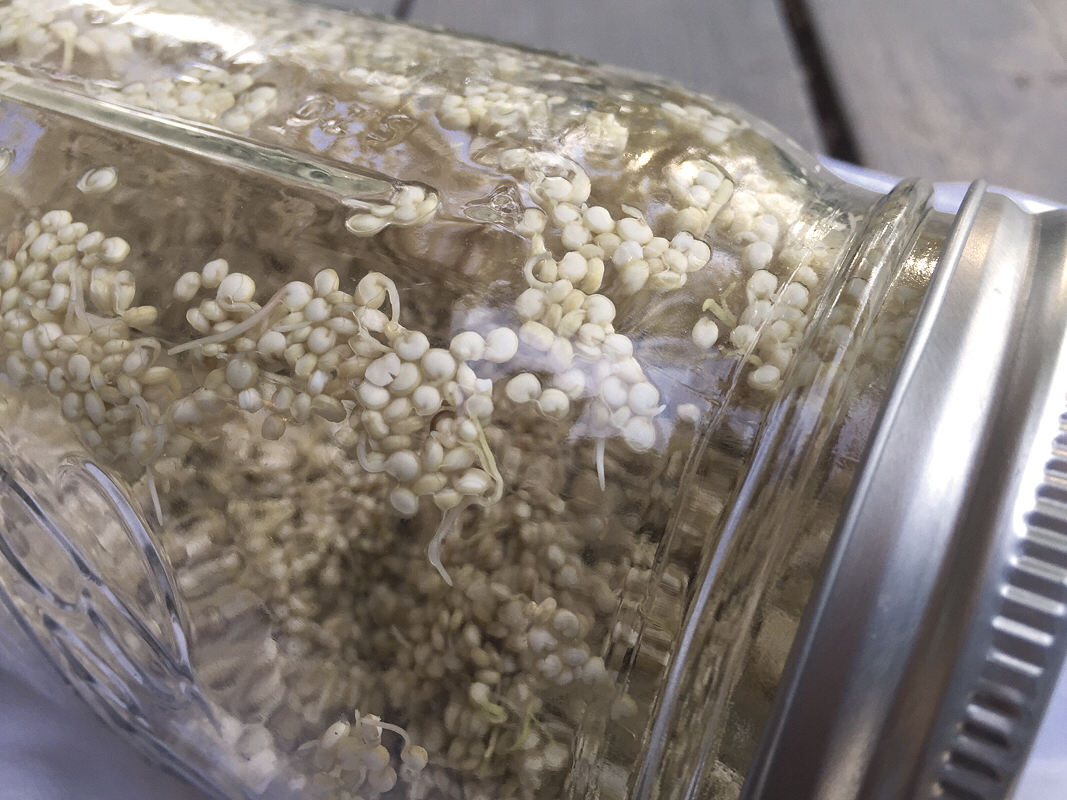|
Soaking and sprouting your seeds, nuts, grains and beans can boost their nutrient value! By soaking and sprouting these foods, you are essentially germinating them. This makes them nutrient dense and easier to digest. Seeds, nuts, grains and beans all have a protective property to them, similar to other animals in the wild (like stingers on bumblebees). These protective properties help keep the seed, nut, grain or bean alive and free from predators along with protecting it from sprouting before it's ready. These protective properties are known as anti-nutrients. These anti-nutrients interfere with our body's ability to digest the minerals and vitamins found in these plants. The most common anti-nutrient is phytic acid. According to the Weston A. Price Foundation, phytic acid can combine with calcium, magnesium, copper, iron and especially zinc in the intestinal tract and block their absorption. This is why a diet high in improperly prepared whole grains may lead to serious mineral deficiencies and bone loss (see the whole article here).
Soaking and sprouting your seeds, nuts, grains and beans is quite easy...it just requires a little pre-planning. Each seed, nut, grain and bean requires different soaking and sprouting times, so reviewing a chart (like the one found here) can be helpful. To start, you need a mason jar. I use a pint size, wide mouth mason jar. You will also need a piece of wire screen to replace the solid metal lid of the mason jar. Place the desired amount of seeds, nuts, grains or beans into the mason jar and fill the jar with filtered water. Allow the seeds, nuts, grains or beans to soak for the appropriate amount of time. Once the soaking is complete, drain the seeds, nuts, grains or beans and rinse them thoroughly with filtered water. At this point, the majority of the anti-nutrients have been removed and you can use the plant as you would normally use it (cook it, eat them raw, add them to smoothies, etc). To add more nutrient density to the seeds, nuts, grains or beans, then ideal thing to do after soaking is to sprout them. Sprouting the plant increases the plants mineral availability. To sprout them, you simply place the mason jar on its side in a window sill that receives non-direct sunlight. Twice a day, rinse the seeds with clean, filtered water, drain them, then lay the jar back on it's side in the window sill. Once you see a small sprout appear (like you see in the photo above), they have sprouted! You can continue to water the seeds, nuts, grains or beans twice daily until the sprouts are the desired height. However, once you see the small, white sprout appear, the nutrient density of the seed, nut, grain or bean has increased and can be used as you would normally use it. The photo you see above is of organic quinoa. I placed 1 cup of quinoa in a mason jar and soaked it for just 2 hours. After the soaking was complete, I rinsed the quinoa, and laid the jar on it's side in the window sill for 18 hours. At that point, I saw little white sprouts starting to appear. The photo above was taken about 24 hours into the sprouting process. Soaking and sprouting your seeds, nuts, grains and beans will not affect the way they taste. This process will just increase the health of the plant by making them easier to digest, increase their nutrients and your body's ability to absorb those nutrients, and decrease the plants anti-nutrients. Use a bit of caution when consuming raw sprouts. The process of sprouting seeds, nuts, grains and beans can make the sprouts susceptible to harmful bacteria. When sprouting your seeds, nuts, grains and beans, make sure to prepare and store them properly. To decrease the risk of ingesting any harmful bacteria, use the sprouted plants quickly and/or cook them in recipes like soups or stir fry's.
1 Comment
11/16/2021 03:00:10 pm
I like how you mentioned that you are germinating them by soaking and sprouting nuts. My cousin mentioned to me last night that her girlfriend loves to eat walnuts and asked me if I have any idea what is the best option to buy for her. Thanks to this informative article and I'll be sure to tell him that he can try the healthy organic sprouted walnut that I know.
Reply
Leave a Reply. |
AuthorTiana Rockwell is a certified nutritional therapist, avid endurance athlete and dark chocolate lover. She believes that by eating REAL food, we can balance our body and reach optimal health and wellness! Archives
May 2022
Categories
All
|



 RSS Feed
RSS Feed